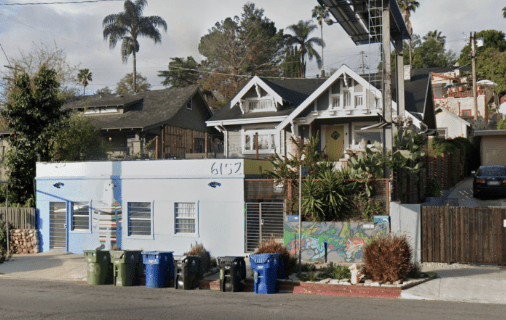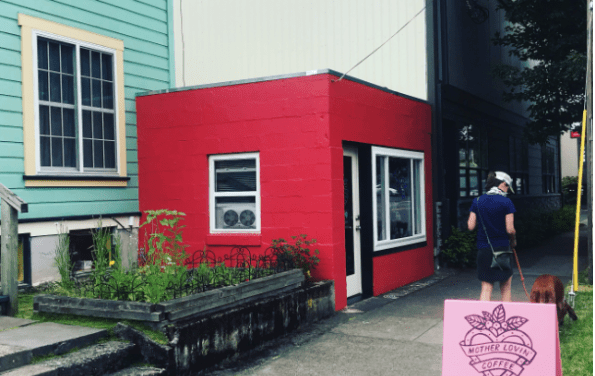Small Retail Can Make Neighborhoods Walkable

As cities seek to fix their affordable-housing crisis, some have legalized accessory dwelling units (ADUs) as a way to add housing in a more incremental fashion and impose minimal change on existing neighborhoods. Less often, cities will allow accessory commercial units (ACUs), which apply the same concept as an ADU, except to retail.
An ACU is a small structure, built on a lot either adjoining or attached to a larger structure, which hosts businesses rather than homes. These structures add commerce to neighborhoods without the construction of large new buildings that residents might find disruptive. Portland, New Orleans, and other U.S. legacy cities are known for their ACUs, which help to make those cities charming and sought-after. So why aren’t ACUs commonplace throughout America, in cities and suburbs alike? The answer, as usual, is zoning.

There are several benefits to having ACU-packed cities. They increase walkability, especially in single-family suburbs where people now largely rely on strip malls for their retail needs. ACUs also allow for the sort of “eyes-on-the-street” density celebrated by Jane Jacobs. And with remote work increasing and people staying all day in their neighborhoods, ACUs would further reduce congestion by shortening or even eradicating many car trips.
ACUs also benefit local entrepreneurs. The cost of opening a business in conventional commercial districts is high; in major markets, businesses typically spend $20-70 per square foot on rent, depending on the city. ACUs, which are cheaper to construct thanks in part to lower square-footage totals, lower this barrier to entry. One prospective entrepreneur told Ashley Salvador of Strong Towns that “if I was able to put $1,800 a month (the cost of her current space) towards a mortgage where we already are living, we could obviously have a much bigger, nicer house and also just enhance the neighborhood, potentially people would love it, you know having a hairstylist in their backyard.”
In this sense, ACUs are a “retail missing middle” between the home office (which is limited, since retail sales generally aren’t allowed to occur in homes), and the capital-intensive nature of leasing a large brick-and-mortar storefront.
Urban-planning consultant Neil Heller, who coined the term “ACU,” argues that they can improve neighborhood commerce and livability while making better use of urban space. In a Zoom interview, Heller claimed that smaller cities ought to embrace incremental “small-scale” development in general, and ACUs in particular. Heller posted several images of ACUs across America that demonstrate how they fit into various neighborhoods.

Heller works with the Incremental Development Alliance, a non-profit specializing in “missing-middle” construction, both residential and commercial. Heller cites South Bend, Ind. as another city that has embraced the idea of ACUs. A piece in the city’s Post-Crescent newspaper observed how the model has bolstered some neighborhoods.
“Instead of funneling tax credits and grants to large-scale developers with the hope that the benefits trickle down to residents, it puts the power in the hands of the people,” said the Post-Crescent‘s Mary Hall.
Unfortunately, ACUs cannot be built in most cities. Zoning laws prohibit their construction due to lot-size requirements or use separation, as do other regulatory restrictions like parking minimums. Where they are permitted, ACUs typically are required to undergo an exhaustive approval process. In Portland, one of the national leaders in ACU construction, ACUs are nevertheless forbidden in neighborhoods zoned for single-family housing. In Raleigh, some types of businesses are allowed to operate out of homes, but there are caps on the number of employees and visitors those businesses are allowed to have. This regulation was presumably instituted to limit neighborhood traffic and crowding, but the downside is that it reduces a business’s sales potential and the potential of ACUs altogether.
Heller argues that this ought to change, because ACUs are inherently less intrusive than most other businesses in a single-family context. Further, he claims the large setbacks on suburban properties provide ample space for ACUs. He doesn’t think legalization will lead to drastic neighborhood change; when it comes to specific types of businesses, “the market’s [going to] sort out their location, just because [neighborhoods have] different requirements, different capture needs.” He says the most common use of ACUs is barbershops— not exactly the sort of traffic generator one might expect of, say, a full-service restaurant or gas station.

But in a hopeful sign, Raleigh hopes to legalize ACUs by giving them a “by-right” designation citywide, meaning they will not be subjected to conditional-use permits. The ordinance would broaden the scope of allowable businesses; a variety of service-oriented firms could operate in structures 1,000 square feet smaller than the adjoining structure (or under 40 percent of its floor area). Buffalo is another example of a city whose zoning code was updated to allow for ACUs, in their case along the Elmwood Avenue corridor.
Writing for Public Square, Garlynn Woodsong proposed that legal frameworks be created to expand the use of ACUs, with size requirements similar to those that exist for ADUs. He presented three model-legislation blueprints—one that permits ACUs on greenways, another that allows them in “new village center nodes,” and a third that legalizes them everywhere. Any of these three would be a good step forward, but universal legalization would promote maximum flexibility and dynamism.
Urbanists praise cities in Europe, Asia, and Latin America for the amount of activity that can be reached without having to drive. It’s common to see images of streets with low car traffic and high pedestrian use praised as a model for U.S. cities to follow. Embracing ACUs would be a small step in this direction. Getting there will require their broad legalization.
As Salvador argued, “Until zoning bylaws explicitly allow ACUs, widespread adoption will be stalled. Banks and insurance companies won’t develop products for them, building codes will struggle to categorize them, and cities will implicitly be saying no [to] the very individuals that could be helping drive our transition towards more equitable, prosperous, and resilient communities.” It’s time for those bylaws to change.
Scott Beyer owns Market Urbanism Report, and is a columnist for the Independent Institute, Governing, and HousingOnline.com. Ethan Finlan is Market Urbanism Report’s content staffer.
This New Urbanism series is supported by the Richard H. Driehaus Foundation. Follow New Urbs on Twitter for a feed dedicated to TAC’s coverage of cities, urbanism, and place.
This article featured additional reporting from Market Urbanism Report content staffer Ethan Finlan.